A PHOTO DISCUSSION ON NUTTING'S
FLYCATCHER IDENTIFICATION:
Part 5: Mouth lining, calls,
and behavior
text © 2003 Don Roberson
all photographs are copyrighted © 2003
by the photographers cited; used here with permission
MOUTH LINING: Lanyon (1961) said that
this "is the most practical and most reliable morphological criterion for
the specific identification of fresh specimens of this complex." Sounds
promising! He "found no evidence that the character varies geographically
or sexually in either species. In my series of 50 specimens of known voice,
there was 100 per cent agreement between the specific determination based
solely on color of mouth linings and those based on certain diagnostic
vocal patterns." Nutting's has "orange-colored mouth linings." All fresh
Ash-throated specimens had "'flesh-colored' mouth linings ('pale ochraceous
buff' of Ridgway 1912)." He concludes by noting that Nutting's groups with
Great Crested and Dusky-capped on mouth lining color, while Ash-throated
groups with Brown-crested. Lanyon's mouth-lining character has been cited
over and over in the literature as diagnostic.
Just reading the above, however, raises some questions. Does his "series
of 50 specimens of known voice" imply there were a maximum of just 25 of
each species? If so, that is a fairly small series compared with the over
400 specimens he used to develop his tail pattern key. Secondly, although
he found no geographic or sexual differences, he doesn't mention age-related
distinctions at all. His study was primarily focused on the question: "is
Nutting's a good species?" (he found it was). But it is clear he focused
on birds on territory — in other words, the evidence suggests very strongly
that his 50 specimens were all adults on the breeding grounds. Thus he
does not answer the question: is there age-related variation in mouth lining
color?
This is an important question. Cardiff & Dittmann (2000), writing
about Brown-crested Flycatcher and discussing its separation from Great
Crested, describe mouth linings. As we have seen above, Nutting's is said
to group with Great Crested and have orange mouth linings, while Ash-throated
groups with Brown-crested with flesh-colored linings. Cardiff & Dittmann
write that "not all [Great Crested] have bright orange-yellow [mouth linings];
LSU specimen data (described as flesh, dull-yellow, and dull yellowish-tan;
these atypical mouth colors may pertain to first-year birds, but
more data needed);" [emphasis added].
If it is possible that the bright orange mouth linings of Great Crested
can be dull yellow or flesh-colored in first-year birds, is it possible
that the same may be true in Nutting's? Given this question — for which
there is no data — I don't see how anyone can conclude that mouth lining
color will diagnostically identify the Santa Cruz bird, since we know for
a fact that it is a first-winter bird.
Further, mouth lining color variation also goes the other direction.
There are specimens of Ash-throated Flycatcher whose data tags state the
mouth lining was "orange" (Bowers & Dunning 1987, cited with approval
by Cardiff & Dittmann 2002).
Bowers & Dunning (1987) published a widely-read paper in American
Birds on a bird they had captured and banded in Santa Cruz Co., Arizona,
on 15 July 1985 (not to be confused with Santa Cruz Co., California; all
reference to "the Santa Cruz bird" in these pages is to the California
bird). They identified it as a Nutting's, and published both photos of
it and comparative material. The bird was heavily worn and called only
once upon extraction from the net; the identification as Nutting's relied
heavily on the presence of orange mouth linings. This identification is
now considered controversial (Cardiff & Dittmann 2002); there is an
on-line statement that the Arizona Bird Records Committee thinks it likely
a worn Ash-throated (although they have never reviewed the record). If
it is an Ash-throated, this is another orange-mouthed Ash-throat beyond
the specimen cited by Bowers & Dunning (1987).
I noticed some interesting points in reviewing the published photos;
I have scanned the relevant pages and reproduce R.W. Bower's photos here
(fair use doctrine; these shots are published at Amer. Birds 41:
8 & 9).
| The first shot (near right) is an Ash-throated that is stated to have
"pink" mouth lining. The second (far right) is the mystery bird, considered
Nutting's in the article, stated to have "orange" mouth lining. I don't
see anything that is nearly that simple. First, the tongues of both birds
are bright pink. Second, the color inside the lower mandible on both birds
is a really dull straw color. The "mouth lining" itself must refer to the
lining deeper in the mouth and (maybe) inside the upper mandible, but it
cannot mean the tongue or the inside of the lower mandible. |
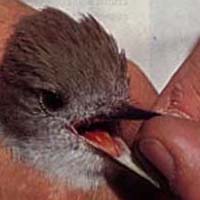
|
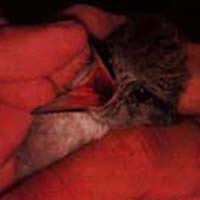 |
The concept that the term mouth lining cannot mean either
(a) the tongue or (b) the lining of the inside of the lower mandible is
supported by discussion in Pyle (1997). In discussing young birds (p. 19)
he says that "The inside of the mouth, including the 'roof' (upper mandible
lining) also is brighter in tone and/or paler in hue in juveniles than
in adults." Since he does not include the "floor" (lower mandible lining)
in this statement, the clear implication is that the color of the lining
of the lower mandible is not a feature of the "mouth lining"
and is not a useful character. Pyle also says that "more study is needed
on changes in the color of the roof of the mouth in these and other species."
Inconsistent with my concept is the fact that recent Birds of North
America fascicles (e.g., Cardiff & Dittmann 2000, 2002) do not
distinguish between the "tongue" and the "mouth lining" in their descriptions
of soft parts. However, it is undeniable that Ash-throated may have a bright
pink tongue (photo above) and so tongue color is not a key.
The key point on mouth lining is the color inside the
actual mouth itself, including (perhaps) the "roof" (upper mandible
lining) but excluding the lower mandible lining, and (probably)
excluding the tongue. Below is a series of four video-caps (© Joel
Weintraub) of the Orange Co., southern California, Nutting's:
 Here is what I see: left photo was a bright pink mouth (maybe due to the
tongue and/or the angle, next is bright orange, third is bright orange
(particularly the upper mandible lining), and the last shows only the lower
mandible lining, which is a dull yellowish color, maybe called "flesh."
Do you agree with this color analysis? There will be a bit more on that
below.
Here is what I see: left photo was a bright pink mouth (maybe due to the
tongue and/or the angle, next is bright orange, third is bright orange
(particularly the upper mandible lining), and the last shows only the lower
mandible lining, which is a dull yellowish color, maybe called "flesh."
Do you agree with this color analysis? There will be a bit more on that
below.
If the key point is the actual color of the inside of the mouth and
upper mandible only, what colors should we see? As discussed above with
reference to Lanyon (1961), Nutting's is orange while Ash-throated has
"'flesh-colored' mouth linings ('pale ochraceous buff' of Ridgway 1912)."
Cardiff & Dittmann (2002) describe Ash-throated mouth lining as "usually
flesh-colored, occasionally yellowish flesh to dull yellowish, rarely orange."
Please note the absence of any reference to pink, let alone bright pink,
by any of these authorities. The only reference to "pink" in Ash-throated
that I find is in Bowers & Dunning (1987), and I suspect it is a reference
to the tongue. Look at their in-hand photo of their undeniable Ash-throated,
reproduced above. The tongue is pink, the bottom of the lower mandible
is a really dull straw, but there is a tiny bit of the mouth lining itself
shown just inside the gape and right of the tongue. It looks dull yellowish
to me, and that color is consistent with the literature descriptions. You
can go check up on "pale ochraceous buff" yourself at an online
color chart; as shown there, it is the equivalent of pale yellowish-pink.
It is rather like the color of the inside of the lower mandible on the
in-hand pictures, above. It is sort-of like the color of the back of your
hand if you are Caucasian and not tanned or sunburnt. It is not anything
like bright pink. So we want to see if the Santa Cruz bird has a dull mouth-lining
that is flesh-colored or pale yellowish-pink (=flesh), or a bright orange
mouth lining that can look bright pink in some views (e.g., the Orange
County bird, left hand shot above).
To help this analysis, I have used the PhotoShop color picker on the
four shots of the Orange County bird, and then created a box with that
color in the lower left of each photo, and then have done the same with
the photos I can find of the Santa Cruz bird. I try to choose the color
in the very center of splash of color and away from edges or shadows:
|
Orange Co. Nutting's [photos © Joel Weintraub]
|
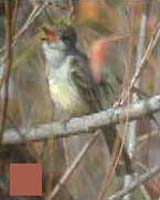
|
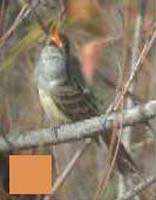
|
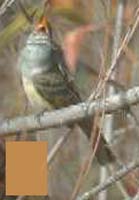
|
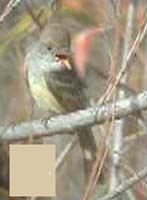
|
|
Santa Cruz bird [photo near right © Cindy Cummings; far right
© Peter LaTourrette]
|
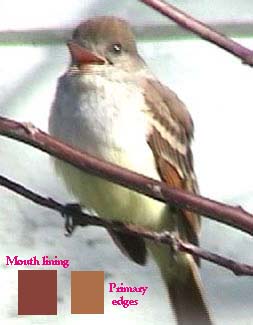
|
No photos show this same angle but described as bright orange but
most observers
|
No photos show this same angle but described as bright orange but
most observers
|
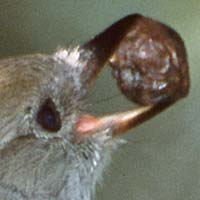
|
Note that when the lighting was good and direct, and the 'roof' (upper
mandible lining) was well seen, the Orange County bird had a bright orange
mouth lining, confirmed by the mechanical ("objective") color picker. And,
as we would expect, the color of the lower mandible lining is a dull yellowish-pink
(=flesh), recalling that the lower mandible lining is not part of the "mouth
lining" color to be analyzed. In the Santa Cruz bird, the bottom row, far
right, photo shows the bird eating an olive. We can see a bright pink tongue
and a dull yellowish lining to the lower mandible, just as we would expect
for either species. This is not a helpful photo for distinguishing between
the species (although it is a really nice shot for behavior!).
So that brings us to the leftmost photo in each row. To my eye, both
photos looked to have bright pink mouth linings deep inside the mouth and
inside the upper mandible. I don't think the tongue is in the way. Yet
the "objective" color picture shows those colors to be a dark maroon! I
think this means that the actual color is somewhat shaded in these shots
and our eyes automatically adapt for that shading to see a bright pink.
I added a box that the color picker chose as the color of the primary edges
to test Cindy Cumming's photo, and it looks "in the ballpark" for the right
color, although tending a bit too brown. There is a remarkable similarity
in the tone of color chosen by the color picker between the lefthand shots
of both the Orange Co. and Santa Cruz birds. We are missing photos of the
Santa Cruz bird with the proper angle of direct light, but, given the experience
with the southern California photos, I would not be at all surprised to
find they would show bright orange. In any event, I hope we can all agree
that Cindy Cumming's photo shows a bird with brightly colored mouth linings,
not dull colored.
Incidentally, most observers of the Santa Cruz bird describe the mouth
lining as orange. But what are they describing? My view was facing the
bird as it ate an olive, I believe the tongue was below the olive, and
I believe I described the color of the upper mandible lining, just as shown
in the photos of the Orange Co. bird, center shots.
Is there a possibility that those who have described a "flesh-colored"
mouth lining were looking at the lining of the lower mandible, as in the
bottom row, far right, photo above? You can determine whether that is a
possibility, and whether you want to give any weight to the descriptions
of "orange" mouth lining from various other observers.
VOCALIZATIONS: In reviewing the literature,
I notice three interesting points about vocalizations among the Myiarchus
flycatchers in the group that is comprised of Nutting's, Ash-throated,
Brown-crested, and Great Crested Flycatchers:
-
First, the standard North American field guides (e.g., National Geographic
1999) and the birder i.d. literature (e.g., Howell & Webb 1994) emphasize
the single diagnostic vocalizations and don't mention the other calls given
by the species. As we shall see below, each species in this set has at
least four standard calls. In his brief i.d. summary, Lanyon (1997) says
the diagnostic calls are: wheep! for Great Crested, WHAY-burg
for Brown-crested, ka-BRICK for Ash-throated, and (in Lanyon 1961),
a clear penetrating whistle peer for Nutting's. National Geographic
(1999) renders these as: a loud, whistled wheep in Great Crested,
a rolling whit-will-do in Brown-crested, a rough prrrt and
a burry ka-brick in Ash-throated, and a rather sharp wheep
in Nutting's. Cardiff & Dittmann (2000, 2002) say the key Brown-crested
call is a diagnostic rasp. A chart in Howell & Webb (1994) says the
call notes are: rising wheep in Great Crested, a two-syllable h-whick
in Brown-crested, a quiet pip in Ash-throated, and an emphatic wheek!
in Nutting's. About the only things that seem sure in this review of vocalizations
is that Great Crested gives a rising wheep and there is a ka-brick
(emphasis on second syllable) in Ash-throated. Other than that, even these
experts don't seem to completely agree on what the diagnostic vocalizations
are.
-
The second interesting point has to do with the evolution of what call
of Nutting's is considered diagnostic. As will be discussed below, Lanyon's
(1961) major study found four basic Nutting's vocalizations. The one he
considered most diagnostic was the clear, penetrating whistle peer,
sometimes lasting longer peeer that was suggestive of the standard
call of Dusky-capped Flycatcher but "usually at a higher frequency" and
"more 'piercing', less 'sad' or plaintive." Lanyon tape-recorded this vocalization
in all populations of Nutting's that he studied. By the time of Bowers
& Dunning (1987) they said the common call of Nutting's was "a smooth,
rising, single-syllable wheep or cheep." Lanyon (1997) kept
his description as peeer for Nutting's, and so did Dittmann &
Cardiff (2000), but Howell & Webb (1994) used "an emphatic wheek",
sometimes rendered as wheep (Howell & Webb 1995), and, as we
have seen, National Geographic called it a "rather sharp wheep."
Therefore, in short, Lanyon's peeer evolved into a Great Crest-like
wheep!
over the course of the decades, and the conventional wisdom is that Nutting's
gives a call similar to Great Crested. This is a curious evolution, and
the conventional wisdom may not be entirely accurate.
-
Dale Zimmerman (1978) described a call on a December Myiarchus in
New Mexico that he transcribed as reeeeeee. He wrote it "was not
a truly clear whistle throughout, but possessed a slightly rough quality
at the beginning of the call." Zimmerman also wrote that the call "was
a rather thin, almost whistled, rising single note — not emphatic (like
the calls of Great Crested M. crinitus) yet not plaintive in quality
(as in that of Olivaceous Flycatcher [this bird now called Dusky-capped]).
It was a little longer than the ordinary "wheep" note of M. crinitus
and was vaguely reminiscent of that. It was, however, much softer,
more nearly whistled, and with no hint of a terminal consonant sound;"
(emphasis in the original). I think it likely that Zimmerman's bird was
a Nutting's, as was published it probably was (he was unable to obtain
confirming visual features of importance). Will Russell, in Internet commentary
on the Arizona bird, said the call was "a sharp weenk like a muted
Great Crested and far from the "police whistle" or soft pwhit notes
from Ash-throated. He also said that "the call was uttered rarely (a seasonal
silence?)." I find it interested that those hearing presumed Nutting's
state the "classic" call is only "vaguely" like a Great Crested, or "like
a muted Great Crested," rather than the conventional wisdom of a strong
similarity.
The most thorough evaluations of the vocalizations of these groups are
Lanyon's (1961) study [Ash-throated and Nutting's] and the Bird of North
America fascicles on Great Crested (Lanyon 1997), Brown-crested (Cardiff
& Dittmann 2000), and Ash-throated (2002). All these major works include
spectrograms of all the calls. Lanyon (1997) says that playback experiments
with both Great Crested and Brown-crested "clearly demonstrate an ability
of each species to discriminate between their vocal repertoires and to
respond positively only to their own." Lanyon (1961) showed that the vocalizations
of Ash-throated and Nutting's were inherent from fledging, hard-wired (as
it were) and not learned (thus unlike sparrows and warblers and other nine-primaried
passerines who learn their vocalizations from hearing their parents and
neighbors while very young).
In the following chart, I've tried to condense what this literature
has to say about vocalizations, lining up similar ones in the same row.
All authors recognize that the birds have "diagnostic" calls and other
non diagnostic calls that are similar to other species (but apparently
the birds can tell even these apart). Both sexes give the four basic calls;
there are combination of calls in Ash-throated and Nutting's that extend
the number of vocalizations to 6 or 7 (Lanyon 1961, Cardiff & Dittmann
2002). There are also male only dawn songs on the breeding grounds that
I do not consider here.
|
Great Crested
|
Brown-crested
|
Ash-throated
|
Nutting's
|
Comments
|
|
huit, can be written wit-whit
|
huit (most frequent call)
|
huit
(Howell & Webb 1994, 1995 describe this as a wet to slightly sharp
pip
or pic, often quite soft)
|
pit-peer (Lanyon); unclear if the pit can be given
alone
|
This is a basic huit, wit, whit, pic
or pip call that may be very difficult to distinguish between the
first 3 species, and possibly the 4th?
|
|
rasp
|
rasp
|
burry urg
|
a low grating note (shown on spectrogram in Lanyon 1961) but not
described in words except that is has an Ash-throated counterpart; Will
Russell described a low grating note on the Arizona Nutting's
|
Hard to grasp this call; Cardiff & Dittmann (2000) considered
it a diagnostic call for Brown-crested, thus obviously the quality of the
note is important
|
|
preeet or purrit
|
a vibrato whistle
|
wheer, combined becomes ha-wheer
|
whee-u (Howell & Webb 1995) but not described in words
in Lanyon (1961)
|
Apparently rather rare notes, except used in combos, esp.
in Ash-throat
|
|
rising whee-eep!
|
whay-burg (emphasis on first syllable)
|
br-ick, always (?) given in combo as ka-brick (emphasis
on second syllable)
|
whistled peer (Lanyon), perhaps now rendered as a sharp
rising wheek (Howell & Webb 1994, 1995)
|
This is the diagnostic calls, although the Ash-throat is
actually a common combo call, and for now I'll assume that Lanyon's peer
is today's wheek! (but I'm not sure of that, and this chart may
be in error on that point)
|
|
-
|
-
|
a combo note that is a rolling series of huits
|
a combo note that is a rapid rolling series, perhaps the wh-ik
wh-ik of Howell & Webb (1995)?
|
This may also be a diagnostic call, at least as to quality, and
is one of the extra combo calls detailed for Ash-throat and Nutting's,
but not the other two
|
Although I did some comparing of spectrograms to come up with this summarized
chart, it seems likely some points were misinterpreted. Lanyon (1961) did
not use words to describe most of his calls, so I tried to find comparative
words out of Howell & Webb (1994, 1995) but could have assigned them
wrongly. So it is the Nutting's column that is most speculative here.
In addition, Joe Morlan has posted sound
files from Chris Benesh and Alvaro Jaramillo that include Nutting's
Flycatchers in Mexico. I am personally unable to access those files (no
broadband at home, no sound card at work) but those who can do so have
found them useful.
Words are a difficult tool to use to describe vocalizations, and most
everyone will use different words for the same calls. For example, five
of us listening to the Santa Cruz bird on 3 January described the calls
this way:
-
"a soft pwip to a sharper pweep (essentially variations on
the same call)" [Steve Gerow]
-
"low pitched, variously quiet to loud, single note, pweet, bweep,
pweep,
or weep, not much of the wh sound as implied by others as
wheep"
[David Suddjian]
-
"poet poet; short but not very loud. This word choice ..
is misleading, as I did not hear a two-syllabled note. Later (when Roberson
showed up), the call was wick wick wick - not with up-slurred wheet.
No long ee sound." [Dan Singer]
-
distinctive sharp, short, pwik call, given often when it was vocalizing,
sometimes could be rendered as wick! This call ... was closer
to a cross between Downy Woodpecker and Least Flycatcher (i.e., between
a pik and a whit)."1 Also often doubled or trebled
pwik-pwik-pwik.
[Don Roberson]
-
a sharp "pweeep" .... recalling a quiet Brown-crested Flycatcher;"
also a "series of abrupt rising notes" [Joe Morlan]
Also, another observer, who thought the call was like an Ash-throated,
described it this way:
-
"both Joe's description .. as a sharp qwip and Don's described of
it as a distinctive sharp, short, pwik ... sound perfectly like
the call that I heard repeatedly (personally described as chirk, drrt,
or possibly wip). In fact, thinking back about it.... I may even go with
a sharp, whistled wip! as the best description for the call I heard."
These descriptions (above) describe the standard call — often given in
a short quick series — heard dozens of times over a several hour observation.
Note the variation in the descriptions (as might be expected) but also
note the similarities. Whatever the call is, it was sharp and whistled.
Please also note that it does not seem to nicely fit into any of the descriptions
of the four species in the table above. We assume it must be there (do
we?) but perhaps the range of variation is wider than thought. Might this
particularly apply to Nutting's, the poorest known of the four species?
You can be judge of that.
Steve Gerow and David Suddjian spent more time with this bird than anyone
else, and they heard two or three other calls, described as follows
-
"when it first started vocalizing in the morning (before it came into view),
I once heard a rolling call among the pweeps which seemed to fit
the description of this sort [of rolling call] in Lanyon (1961)" [Steve
Gerow]
-
"while is was perched above us, it once gave a much louder, sharper, and
longer variation of its normal call, an upslurred pwheeet, that
may be what some describe as the 'typical' call" [Steve Gerow]
-
"several calls that were louder and sharper than what I've mostly been
hearing from it (which were weep or pweep type calls). The
louder calls could be characterized as a variation of the calls I'd heard
before. I noted them as pweeet! or pweeek! This call was
more drawn out than the other call and a bit upslurred." [David Suddjian]
-
"once as the bird flew in from some distance, [it gave a] quick call something
like pit-tur-brit, with emphasis on the last syllable and with a
rolling quality reminiscent of the calls of Ash-throated Flycatcher" but
"I don't think I would characterize that one-time call as rough or burry...but
it is hard to get too exact about a quick call heard once." [David Suddjian]
To my knowledge, no one has heard a burry call, or a throaty ka-brick,
or any of the "typical" Ash-throated calls. You can decide for yourself
whether any of descriptions recall the "wet to slightly sharp" whit
or huit of Ash-throated. You may also develop an opinion on whether
the "sharp, short" whistled pwik or pweep calls are actually
a shortened version of a longer wheek call, now considered diagnostic
of Nutting's. Could winter calls be different than summer calls in length
and intensity? The Arizona Nutting's called most frequently during interactions
with a wintering Ash-throated [Will Russell, commentary]. Could the presence
of other Myiarchus intensify calling?
BEHAVIOR: One of the immediately curious
aspects of the Santa Cruz bird was that it spent most of its time eating
olives. It would take them off the olive tree, or, just as frequently,
pick them off the ground under the tree. It would "shake it and beat it
against a branch or the ground, in a manner of a large flycatcher or tanager
dealing with an insect" (to quote David Suddjian), and then swallow them
whole. The pit was later regurgitated. "It dropped a number of olives in
the process, either by choice or unintentionally. It ate olives that were
ripe and firm, as well as those that were over-ripe and partly shriveled;"
[D.L. Suddjian]. For some time, it appeared that this was entirely "an
olivacecous flycatcher."2
I thought it very odd that a flycatcher in the genus Myiarchus
should be fruit-eating (although I was aware that flycatchers of other
tropical genera ate fruit regularly). David Suddjian, however, who has
spent hours with the bird, also "saw it forage for insects or other invertebrates
several times." He estimated the foraging time was split 70% of olives
and 30% of insects. He eventually found it also eating berries at a cottoneaster
tree.
Both the Nutting's in Arizona and the Nutting's in southern California
spent a lot of time eating fruit. However, all 3 North American species
of Myiarchus are known to ingest some fruit on their wintering grounds
(Lanyon 1997, Cardiff & Dittmann 2000, 2002). While Ash-throated is
almost exclusively a carnivore on arthropods in the breeding season, it
will eat fruit in migration or the wintering grounds. Vegetable matter
was in 13% of 91 stomachs collected in California between April-December
(the percentage in winter not quantified; Cardiff & Dittmann 2002).
The other pages in this project are:
Footnotes
1 Later I learned that some "helpfully" retranslated
this reference of a cross between a Downy Woodpecker and a Least Flycatcher
to conclude the bird gave a standard Ash-throated whit or wit.
Actually, we were listening to a Downy calling in the background -- a sharp
pik
-- and the sharpness of the flycatcher call was in that category, but there
was a 'pw' sound, so that's where a throw-away reference to Least
Flycatcher came in. The call was much closer to the woodpecker. It had
no 'wetness' to it like a call rendered whit or wit would
have.
2 Okay, this is a pun. If you don't get it, you are too young.
I don't know if puns are worthy of "credit," but this is a David Suddjian
pun. [If you are still scratching your head, please recall that Dusky-capped
Flycatcher was known as Olivaceous Flycatcher some decades ago (for its
color, not diet), and this Santa Cruz bird was first thought to be an Olivaceous,
err, Dusky-capped Flycatcher.
LITERATURE CITED:
-
Bowers, R.K., Jr., and J.B. Dunning, Jr. 1987. Nutting's Flycatcher (Myiarchus
nuttingi) from Arizona. Amer. Birds 41:5-10.
-
Cardiff, S.W., and D.L. Dittmann. 2000. Brown-crested Flycatcher (Myiarchus
tyrannulus) in The Birds of North America, No. 496 (A. Poole
and F. Gill, eds.). The Birds of North America, Inc., Philadelphia, PA.
-
Cardiff, S.W., and D.L. Dittmann. 2002. Ash-throated Flycatcher (Myiarchus
cinerascens) in The Birds of North America, No. 664 (A. Poole
and F. Gill, eds.). The Birds of North America, Inc., Philadelphia, PA.
-
Devillers, P. 1971. The alleged occurrence of Nutting's Flycatcher in Baja
California. Calif. Birds 2:140.
-
Dickerman, R.W., and A.R. Phillips. 1953. First United States record of
Myiarchus
nuttingi. Condor 55:101-102.
-
Dittmann, D.L., and S.W. Cardiff. 2000. Let's take another look: Myiarchus
flycatchers. LOS News 193:3-10. Louisiana Ornithol. Society, Baton Rouge.
-
Howell, S.N.G., and S. Webb. 1994. Field identification of Myiarchus
flycatchers in Mexico. Cotinga 2:20-25.
-
Howell, S.N.G., and S. Webb. 1995. A Guide to the Birds of Mexico and northern
Central America. Oxford Univ. Press, New York.
-
Lanyon, W.E. 1961. Specific limits and distribution of Ash-throated and
Nutting flycatchers. Condor 63:421-449.
-
Lanyon, W.E. 1997. Great Crested Flycatcher (Myiarchus crinitus)
in
The Birds of North America, No. 300 (A. Poole and F. Gill, eds.). The Birds
of North America, Inc., Philadelphia, PA.
-
Murphy, W.L. 1982. The Ash-throated Flycatcher in the East: an overview.
Amer. Birds 36:241-247.
-
National Geographic Society. 1999. Field Guide to the Birds of North America,
3rd ed. Nat. Geogr. Soc., Washington, D.C.
-
Phillips, A.R., and W.E. Lanyon. 1970. Additional notes on the flycatchers
of eastern North America. Bird-Banding 41:190-197.
-
Pyle, P. 1997. Identification Guide to North American Birds, Part I: Columbidae
to Ploceidae. Slate Creek Press, Bolinas, CA.
-
Zimmerman, D.A. 1978. A probable Nutting's Flycatcher in southwestern New
Mexico. West. Birds 9:135-136.
TOP
GO TO MONTEREY
COUNTY PAGE
GO TO HOME PAGE
GO TO
IDENTIFICATION PAGE
GO TO BIRDING THE
WORLD PAGE
GO TO BIRD FAMILIES
OF THE WORLD
Page created 23 Jan-3 Feb 2003



